数据模拟
模拟一个信号 \( S(\underline{t}_N, \overline{w})\),其中,\(\underline{t}_N \) 是一个规律性分布的点的集合,点集大小为 \(N\)。 \[\begin{equation}
\underline{t}_N = \begin{bmatrix}
0\\
1\\
...\\
N-1
\end{bmatrix}
\end{equation}\] 1
2
3
4# sample size
N = 1000
# observation epochs (we assume to sample the signal on a regular basis
t = np.arange(0, N, 1).reshape((N, 1)) # a column vector
1 | # signal covariance model |
对应的协方差矩阵为: \[\begin{equation} \begin{aligned} C_{S_{N\times N}} &= \begin{bmatrix} C_S(0) & C_S(1) & C_S(2) & ... & C_S(N-1) \\ C_S(1) & C_S(0) & C_S(1) & ... & C_S(N-2) \\ ... \\ C_S(N-1) & C_S(N-2) & C_S(N-3) & ... & C_S(0) \end{bmatrix} \\ &= \begin{bmatrix} A_0 & A_0e^{-\alpha_0\times 1} & A_0e^{-\alpha_0\times 2} & ... & A_0e^{-\alpha_0\times (N-1))} \\ A_0e^{-\alpha_0\times 1} & A_0 & A_0e^{-\alpha_0\times 1} & ... & A_0e^{-\alpha_0\times (N-2))} \\ ... \\ A_0e^{-\alpha_0\times (N-1))} & A_0e^{-\alpha_0\times (N-2))} & A_0e^{-\alpha_0\times (N-2))} & ... & A_0 \end{bmatrix} \end{aligned} \end{equation}\]
由于数据规律性分布(\(\triangle = 1\)),因此,其协方差矩阵是 T 型矩阵。
T型矩阵(Toeplitz matrix):主对角线上的元素相等,平行于主对角线的线上的元素也相等;矩阵中的各元素关于次对角线对称,即T型矩阵为次对称矩阵。
1 | from scipy.linalg import toeplitz |
将协方差矩阵进行 Cholesky 分解:\(C_S = L\times L^+ \)
Cholesky 分解:把一个对称正定的矩阵表示成一个下三角矩阵 L 和其转置的乘积的分解。它要求矩阵的所有特征值必须大于零,故分解的下三角的对角元也是大于零的。
1 | # Cholesky decomposition C=LxL' (L=lower triangular matrix) |
假设 \(\underline{X}_N\) 是一个满足正态分布的随机变量,具有以下性质: \[\begin{equation} \begin{aligned} E\{\underline{X}_N\} &= 0 \\ C_{\underline{X}\underline{X}} &= I \end{aligned} \end{equation}\]
令随机变量 \( S(\underline{t}_N, w)\) 为 \(\underline{X}_N\) 的一个线性变换: \[\begin{equation} S(\underline{t}_N, w) = L\times \underline{X}_N \end{equation}\] 则其具有以下性质: \[\begin{equation} \begin{aligned} E\{S(\underline{t}_N, w)\} &= L\times E\{\underline{X}_N\} \\ &= \underline{0} \\ C_{SS} &= L\times C_{\underline{X}\underline{X}}\times L^{+} \\ &= L\times L^{+} (\text{满足上面的 Cholesky 分解}) \end{aligned} \end{equation}\]
故而模拟的信号可以由以下等式给出: \[\begin{equation} S(\underline{t}_N) = L\times {\underline{x}_N}^{0} \end{equation}\]
其中,\({\underline{x}_N}^{0}\) 是 \(\underline{X}_N\) 的一个样本
1 | # signal sampling simulation |
增加随机白噪声(random white-noise)\(\underline{v}\),其方差为 \(\sigma_v^2\)。 1
2
3
4# noise standard deviation 40% of signal
sigma_v = 0.4 * np.sqrt(cf[0,0])
# white noise generation (normal white noise)
v = sigma_v * np.random.randn(N,1)
因此,最终模拟的数据为: \[\begin{equation} \underline{y}_0 = S(\underline{t}_N) + \underline{v} \end{equation}\]
1 | # observations (sampled signal + white noise |
绘图查看: 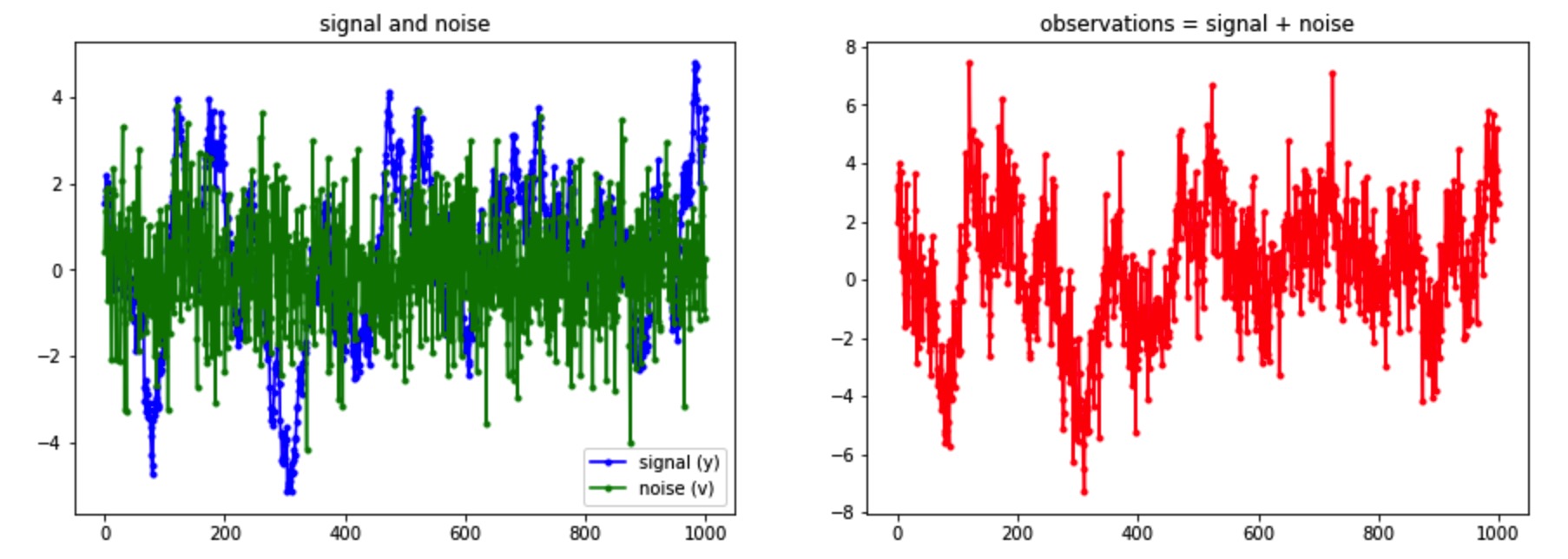
估测经验协方差函数(ESTIMATION OF THE ECF)
1 | # observation mean removal |
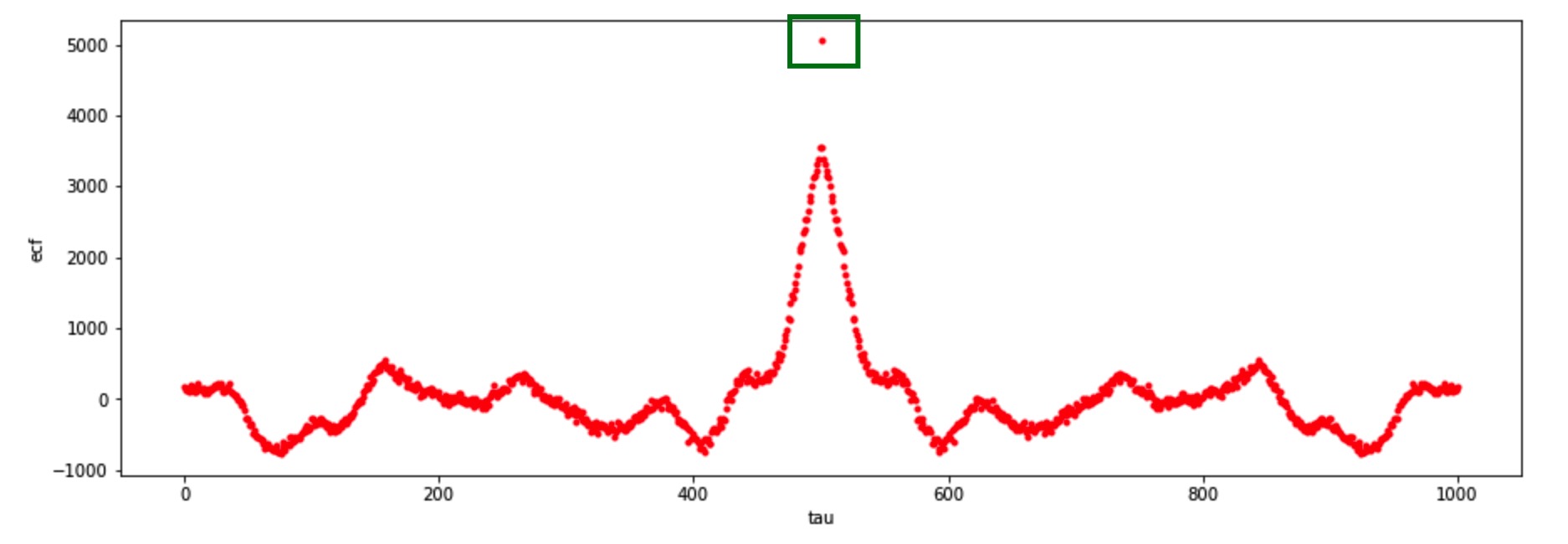
1 | ecf = ecf[N2:2*N2+1].reshape((N2+1, 1)) |

注意:每次运行得到的协方差系数是不一样的,而我们用于计算的模型基于观测值(样本)和噪音。因此,不同的观测值(样本)得到的模型不同。
插值法(INTERPOLATION OF THE ECF)估测协方差函数 \(\hat{CF}\)
这里,我们使用指数模型: \[\begin{equation} CF = A_0e^{(-\alpha_0(|t-t'|))} \end{equation}\]
使用最小二乘法(LS)估测参数 \(\hat{A_0}\) 和 \(\hat{\alpha_0}\)。
1. 确定参数的近似值 \(\widetilde{A}\) 和 \(\widetilde{\alpha}\)
利用第 2 和 第 3 个协方差系数来估算 \(\widetilde{A}\),利用相关长度(correlation length)估算 \(\widetilde{\alpha}\) \[\begin{equation} \begin{aligned} \widetilde{A} &= 2 \times CF(1) - CF(2) \\ \hat{\sigma _{0}}^{2} &= CF(0) - \widetilde{A} \\ \frac{\widetilde{A}}{2} &= \widetilde{A}*e^{(-\widetilde{\alpha}(|\bar{\tau }|))} \\ ln{\frac{1}{2}} &= -\widetilde{\alpha}(|\bar{\tau }|) \\ -ln{2} &= -\widetilde{\alpha}(|\bar{\tau }|) \\ \widetilde{\alpha} &= \frac{ln2}{|\bar{\tau }|} \end{aligned} \end{equation}\]
1 | # approximated values of the parameters for linearization |
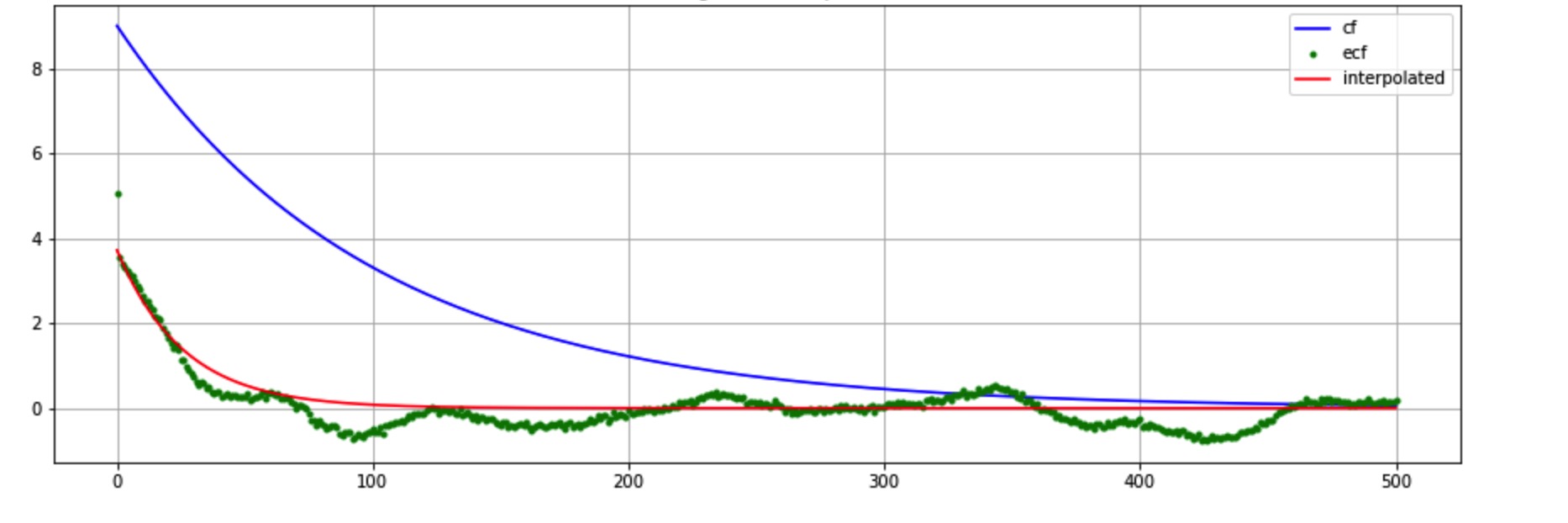
2. 迭代估测
这里,我们仅迭代五次: 1
2
3
4
5
6
7
8
9
10
11
12
13
14
15
16
17
18
19
20
21
22
23
24
25
26
27
28
29
30
31
32
33
34i_up = np.argwhere(ecf[1:]-ecf[:-1]>=0).min(0)[0]
t_up = t[i_up,0]
#print(i_up, t[1:i_up+1])
# point selection for LS interpolation
t0 = t[1:i_up+1] # confusion here!!!
# ecf values to be interpolated
ecf0 = ecf[1:i_up+1]
# first iteration
Ast = Ast01
ast = ast01
# cf
ecm = Ast * np.exp(-ast*t)
plt.plot(t[:M+1], ecm[:M+1], 'r', label='ecm')
for i in range(5):
# design matrix (Jacobian)
A = np.hstack([np.exp(-ast*t0),-Ast*t0*np.exp(-ast*t0)])
# known terms vector
a = np.asmatrix(Ast * np.exp(-ast*t0))
#print(A, A.shape, a.shape, ecf0.shape, t0.shape)
# estimated parameters
xst = inv(A.T.dot(A)).dot(A.T).dot(ecf0-a)
#print(xst, xst.shape)
# i-th iteration
Ast += xst[0,0]
ast += xst[1,0]
#print(Ast, ast, M)
# cf
ecm = Ast * np.exp(-ast*t)
#print(t.shape, ecm.shape)
plt.plot(t[:M], ecm[:M], 'r')
sigma2st_v = ecf[0,0] - Ast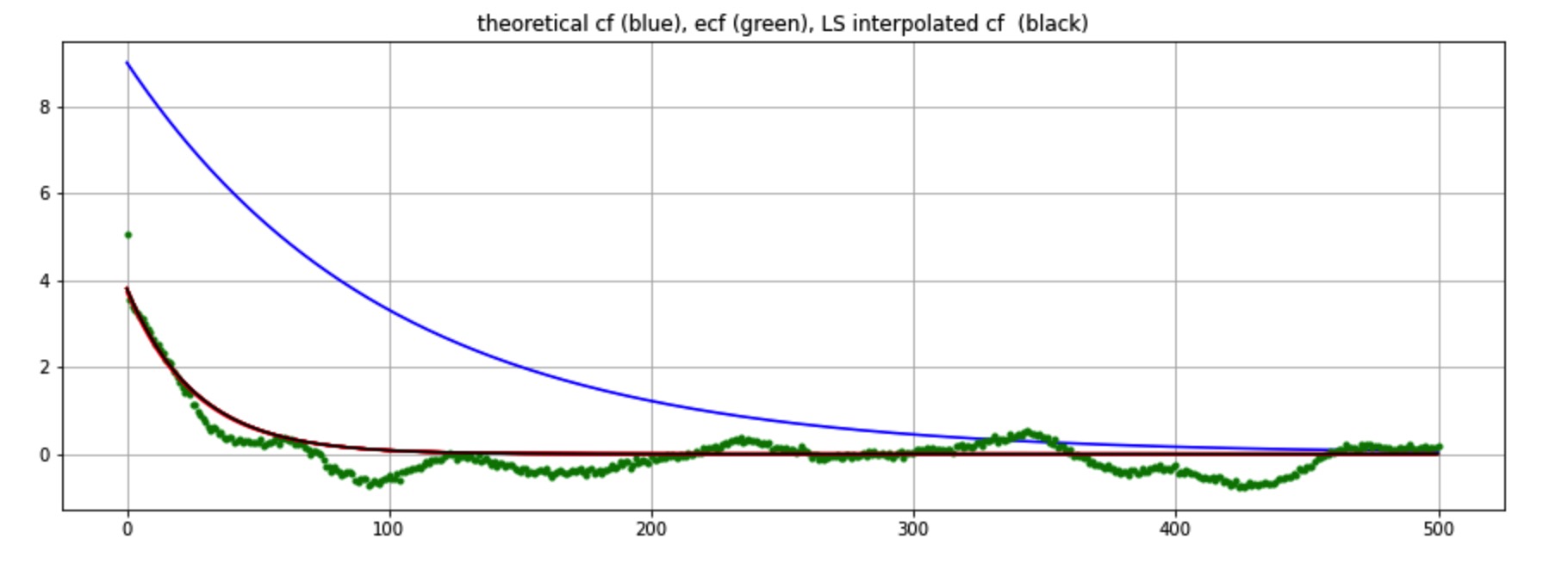
使用观测值和协方差函数 \(\hat{CF}\) 预测指定点集的信号值
- 观测值:\( \underline{y}_0 \)
- 协方差函数: \[\begin{equation} \hat{CF} = \hat{A_0}e^{(-\hat{\alpha_0}(|t-t'|))} \end{equation}\]
- 预测: \[\begin{equation} \hat{y} = C_{yy} \times (C_{yy}+k\times(\hat{\sigma _{0}}^{2}\times I_{N\times N}))^{-1} \times y_0 \end{equation}\]
1 | # number of observations to filter |
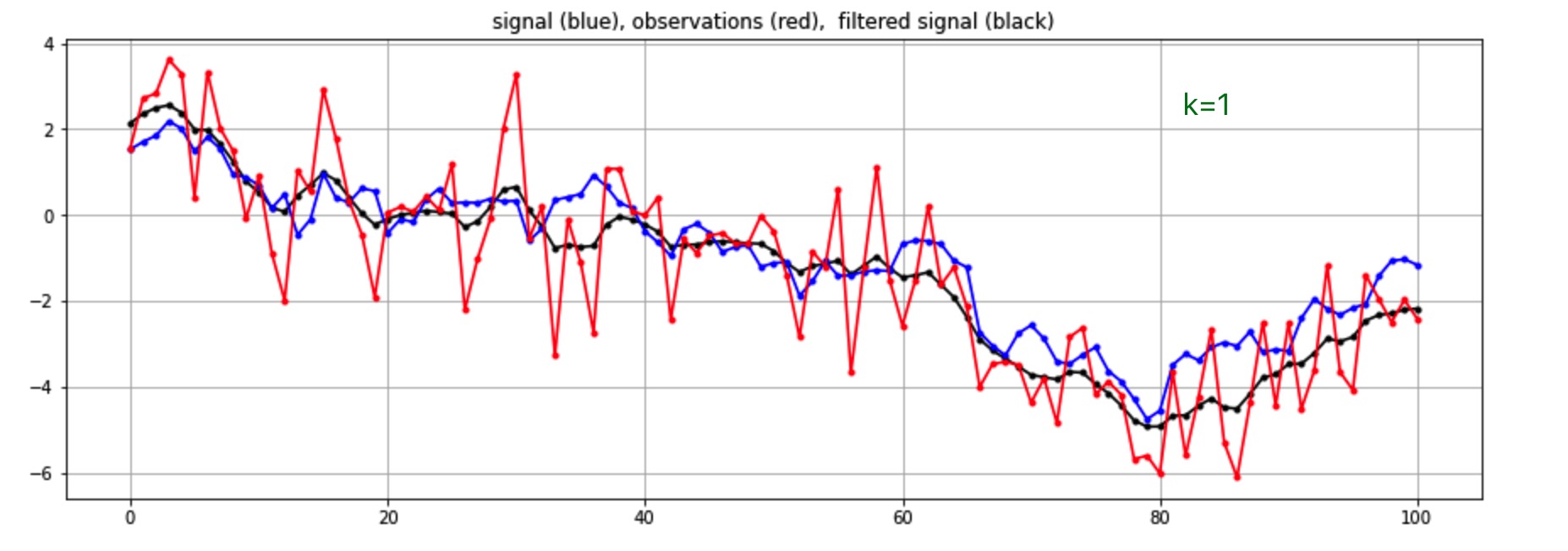
1 | # Covariance matrix of the sampled signal |

可以看出,k 值越大,noise 的方差越大,估测信号越平滑。
如果我们修改相关长度(correlation length)的大小: 1
2
3
4
5
6
7
8
9
10
11
12
13
14
15
16ecmErr = Ast * np.exp(-0.1*ast*t)
Cyy = toeplitz(ecmErr[:n+1])
# Covariance matrix of the sampled signal + noise
Cy0y0 = Cyy + 9*np.eye(n+1)*sigma2st_v # smoother
# filtered signal
yst = Cyy.dot(inv(Cy0y0)).dot(y0_m[:n+1])
est = y[:n+1] - yst
print("""
estimation error:
mean\t\t= {}
std\t\t= {}
""".format(np.mean(est), np.std(est)))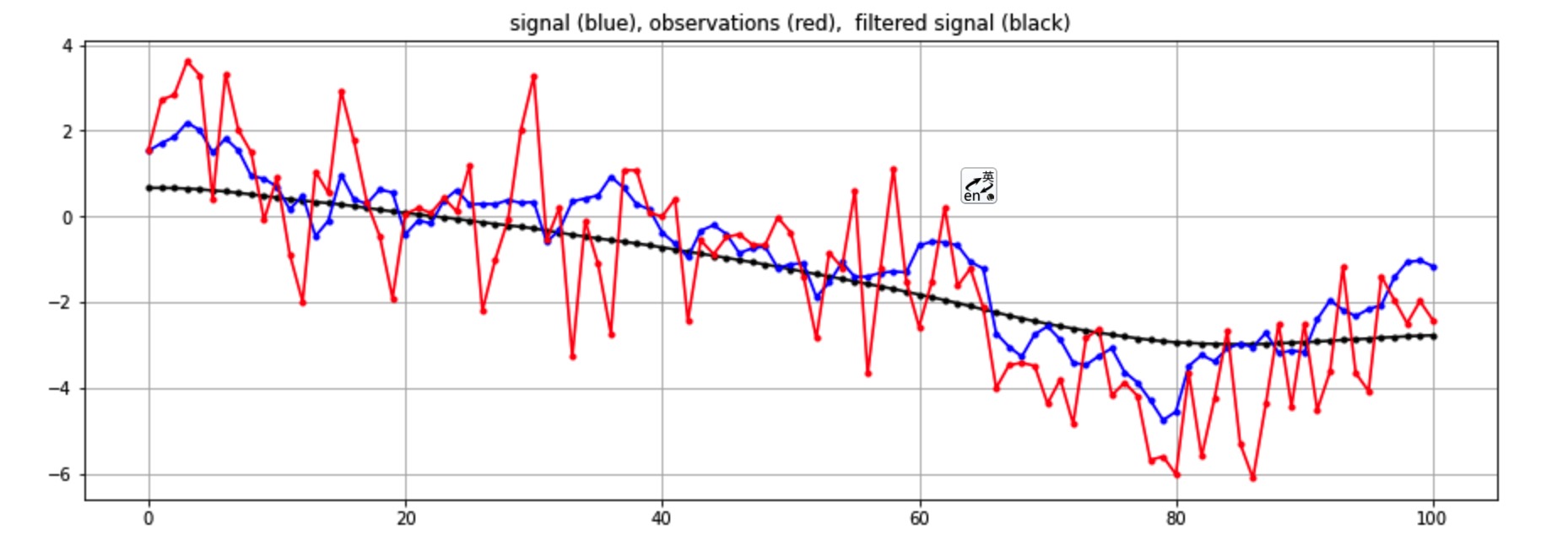
可以看出,相关长度越大,估测信号越平滑;相关长度越小,用以估测信号的观测值越少,估测信号越接近观测值,过滤能力越弱。

